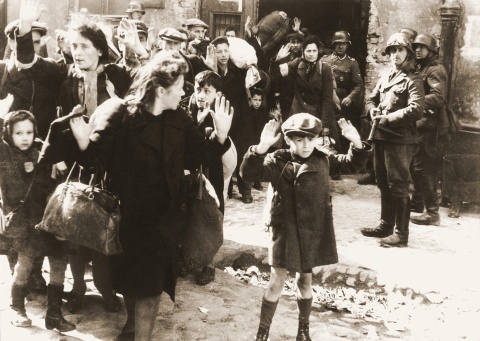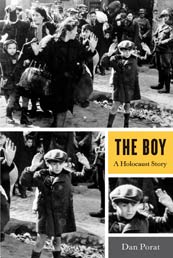
The Boy: A Holocaust Story is a well-researched narrative that focuses specifically on one of the most familiar and iconic photographs from the Holocaust. Indeed, throughout modern history, photographs taken within the context of conflict have often captured the essence of “a picture is worth a thousand words.” They become etched in our psyche, recalled at a moment’s notice. Several of them can be recited from memory: the Marines at Iwo Jima; Vietnam’s Kim Phuc Phan Thi; the standoff at Tiananmen Square; the boy and the liquidation of the Warsaw ghetto.
Written by Dan Porat, an associate professor of education at Jerusalem’s Hebrew University, The Boy is not a memoir, nor is it to be considered a work of academic history. The book reads as a fast-paced suspense story, weaving together the historical backgrounds of the three Nazis who each played a role in the picture we see today: Jürgen Stroop, an ambitious SS Brigadeführer, assigned by Himmler to liquidate the ghetto; Franz Konrad, the man who took the picture and adjutant to Stroop; and Josef Blösche, the soldier standing behind the boy, looking directly at the camera.
Mr. Porat skillfully alternates between each of the three men beginning with pre-WWI Germany. He cites sources that provide the reader with insight into the lives of each, lives that can only be described as mediocre at best. Indeed, if the author’s work tells us anything about these men, it’s that they were not the inhumane murderers that they would ultimately become once the war and the genocide of European Jewry commenced. Further to the point, while both Stroop and Konrad would not re-enter civilian life after the war (they were executed in 1952), Blösche did, and quite successfully, marrying and fathering two children. After the Stasi discovered his whereabouts in East Germany, we are provided with letters written by his wife to the prosecutor, where she states “that after 17 years of marriage to my husband, I have now, as before, confidence and trust in him.” Blösche was put to death in 1967, never to read the final letter sent to him by his wife.
 As the author changes scenes and parallel paths the lives of the three soldiers, he also integrates the story of Rivkah, a young Jewish woman active in the Łódź Jewish community who survives the war by securing false papers that would enable her to live and work among ‘Aryan’ Warsaw. Through the first half of the book, it is not clear to the reader how Rivkah’s story of survival intersects the picture of the boy, creating both tension and curiosity that, in hindsight, would be missing had it not been included. True, Rivkah’s tale of escape and elusion is not unusual when compared to other books written about the Holocaust. But what makes the Rivkah inclusion effective is how it wraps context around that very moment when the picture was taken.
As the author changes scenes and parallel paths the lives of the three soldiers, he also integrates the story of Rivkah, a young Jewish woman active in the Łódź Jewish community who survives the war by securing false papers that would enable her to live and work among ‘Aryan’ Warsaw. Through the first half of the book, it is not clear to the reader how Rivkah’s story of survival intersects the picture of the boy, creating both tension and curiosity that, in hindsight, would be missing had it not been included. True, Rivkah’s tale of escape and elusion is not unusual when compared to other books written about the Holocaust. But what makes the Rivkah inclusion effective is how it wraps context around that very moment when the picture was taken.
As for the boy, the information shared is the information that is available from news clippings. What we do learn is how an individual in New York inadvertently arrived at the possibility that he might be the boy in the picture. To his credit, Dr. Tsvi Nussbaum did not emphatically state that he was the boy; he readily admitted doubt, helped along by critics who pointed out that the victims in the picture were wearing heavy clothing, indicating the picture was most likely taken in early Spring, countering Dr. Nussbaum’s assertion that the picture was taken in July. Sadly, we are left with a mystery that cannot be solved with any degree of certainty.
The Boy is a welcome addition to our understanding of what happened seven decades ago, for it differentiates itself by not simply telling stories of Nazi brutality. Dan Porat correctly believes that “to understand a historical event as presented in a photograph, narration is essential.” He achieves this through a careful mix of in-depth research and judicious imagination. To this last point, Mr. Porat’s use of imagination to round out the story “is disciplined.” He does “not speculate in the way a writer of historical fiction might. It is a controlled usage, aided by analytical tools and clearly circumscribed.”
While the author readily admits to his use of imagination, he makes clear that the facts are taken directly from verifiable sources, and in some instances accounts were corroborated with a second set of sources. In other words, deniers, whoever and wherever they may be, will once again be denied.
Brian Stern is a career-changer and a graduate student in the International Affairs program at New School University in New York, concentrating on Conflict and Security studies. He also holds an MBA in Marketing from LaSalle University in Philadelphia.
—
The Boy: A Holocaust Story
By Dan Porat
MacMillan Publishing (2010)
Further Reading on E-International Relations
- The Dark Heritage of Holocaust Exterminators at Leisure
- Korean Civil Society Organizations: Accomplishments and Expectations
- Remembering D-Day: Questioning How We Compartmentalize War
- Opposition to Comfort Women Memorials in the United States
- The Comfort Women Controversy in the American Public Square
- American Policy towards Czechoslovakia, 1918–1945
